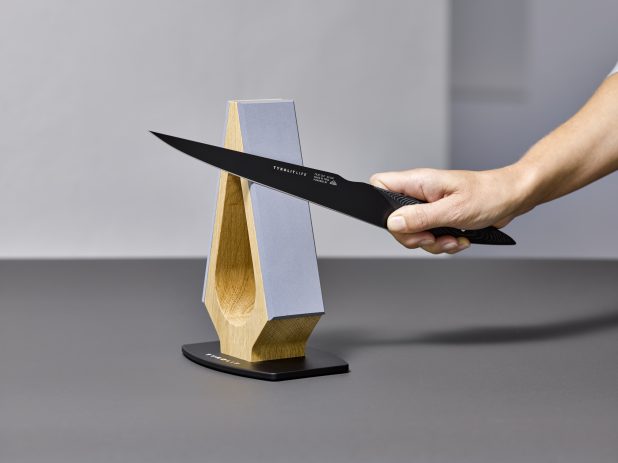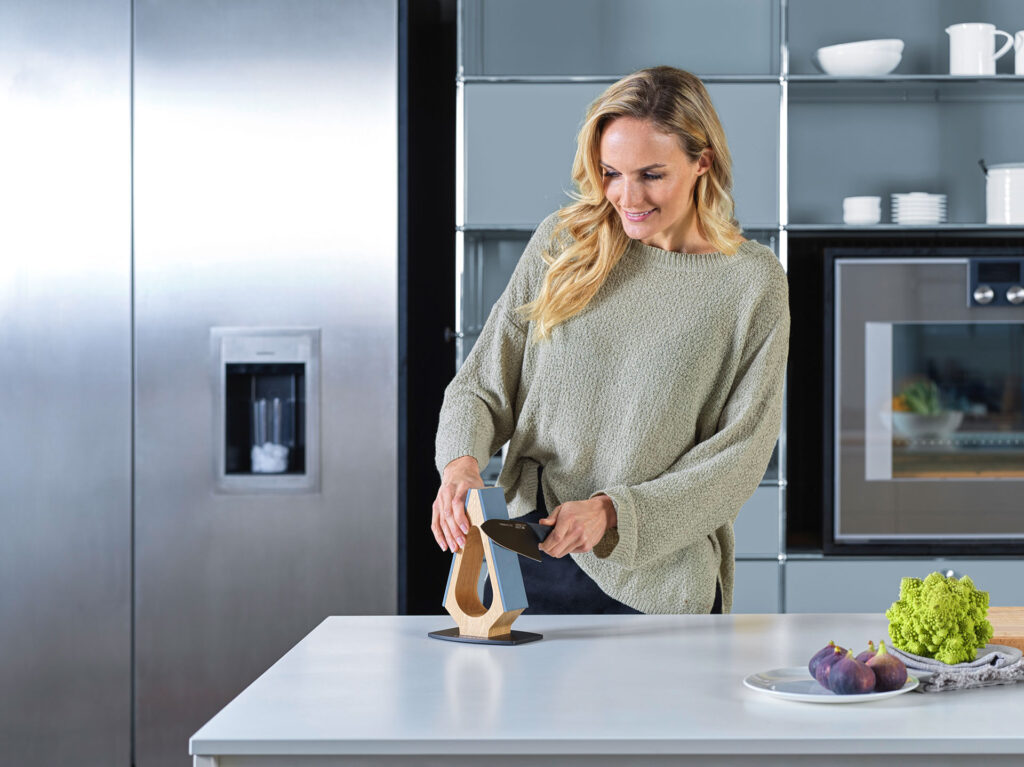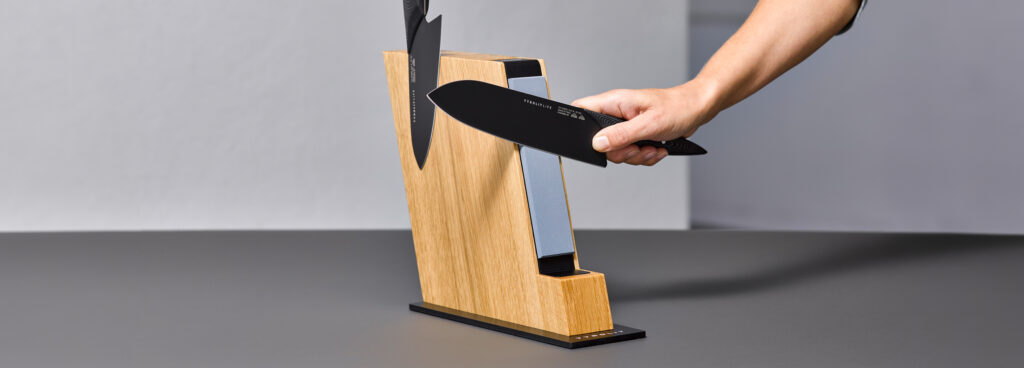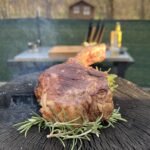Grindstone vs. Knife Sharpener

Grindstone (whetstone) or knife sharpener? This is the key question for both amateur and professional chefs when it comes to sharpening their knives. Both systems are widely used and are similar in many ways. But there are crucial differences in their handling and suitability, so that many ask themselves the question: Which solution is ideal for me?
Certainly, every high-quality kitchen knife can only reach its peak performance when it is sharpened correctly and on a regular basis. Hence, we will delve deeper into the differences and applications of whetstones and knife sharpeners in this article. Moreover, we will reveal how you can achieve optimal sharpening results with knife sharpeners from Tyrolit, the abrasive expert based in Tyrol.
Sharpening Knives – What’s the Purpose?
Regularly sharpening knives is a crucial aspect of kitchen care that goes far beyond the mere sharpness of the blade. A well-sharpened knife improves efficiency and precision when cutting and contributes to safety in the kitchen. With a sharp blade, ingredients can be cut effortlessly, which shortens the preparation time and makes it easier to control the knife.
The sharpness of a knife also influences the texture of the food. A precisely sharpened knife cuts through vegetables, meat or bread with ease, leaving clean cutting edges. This preserves the natural flavors of the ingredients, and the preparation of dishes becomes a pleasant and effective process.
Another important aspect of knife sharpening is the extension of the blade’s lifespan. Through regular sharpening, the development of dings and unevenness, which often occur with dull blades, is prevented. This ensures that the knife maintains its sharpness longer and becomes less prone to damage.
Whetstone – What Sets It Apart
A sharpening stone, also known as a whetstone, is a traditional tool used for knife sharpening. Here are the features that are characteristic of the sharpening stone:
Grits: The sharpening stone is available in various grits, ranging from coarse to fine. Coarse grits (for example, a 400 grit) are suitable for grinding heavily worn blades when the basic grind needs to be restored. Fine grits, on the other hand (such as 800 grit), are used for fine sharpening and are especially applied for regular re-sharpening before cooking.
Different materials of grindstones: Different types of grindstones result from different materials, including natural stones or synthetic materials such as aluminum oxide. Ceramic grindstones are also frequently used.
Skill is Required: Sharpening with a whetstone allows for precise control over the sharpening process, but it demands a certain level of skill. The knife must be guided over the stone at a specific angle (approximately 15° for most European types of knives, whereas Japanese knives are typically sharpened to a finer edge).
To remedy this, the Tyrolit knife sharpener offers a preset sharpening angle, but at the same time a high degree of control when sharpening.

Knife sharpeners – that’s why they’re so popular
Modern knife sharpeners have become popular tools for knife care and offer a number of advantages. Here are some reasons why knife sharpeners are so popular:
Different materials: Knife sharpeners can also be made from different materials. The variety is all the greater because of the different types of knife sharpeners.
Ease of use: Knife sharpeners are often easy to use and require less dexterity compared to the sharpening stone. The automatic or predefined settings make them particularly user-friendly, even for beginners.
Time efficiency: Using knife sharpeners can be more time-saving than sharpening with a sharpening stone. They allow for quick results, which is especially appreciated in hectic kitchen environments.
Precision: High-quality knife sharpeners provide precise sharpening results because they are equipped with special sharpening technologies. Some models even offer multiple sharpening settings for different requirements.
Electrical Options: Electric knife sharpeners provide convenience and are well-suited for intensive sharpening tasks. However, they are often expensive to buy and can sometimes offer less control during the sharpening process.
Sharpening stone vs. knife sharpener: the differences at a glance
The decision between a whetstone and a knife sharpener often raises questions, as both sharpening methods are widely used. There are clear differences in their application and functionality:
The grindstone is a traditional tool that is operated manually – it is said to have been used by the Neanderthals to grind shells.1 The different types of grindstone offer a wide range of grits for different grinding tasks. Use requires dexterity and practice, as the knife must be passed over the stone at a certain angle. Grinding stones are available in various materials, including natural stones and synthetic variants.
In contrast, knife sharpeners are convenient, electrical, or manual devices that are prized for their ease of use. They are especially suitable for beginners as they require less skill. Knife sharpeners often offer preset sharpening angles and are usually time-efficient.
The Tyrolit knife sharpener showcases its strengths here, merging the benefits of a traditional sharpening stone with those of a conventional knife sharpener. Each of its sides features a sharpening stone, one with a 400 grit and the other with an 800 grit, each set at a pre-determined angle of 15 degrees. This design makes the knife sharpener suitable for the simple grinding and sharpening of most types of European knives, enabling even beginners to achieve professional-grade sharpening results.
Sharpening Your Own Knives – A Matter of Grit and Angle
With the right equipment, even beginners can sharpen their knives themselves. However, whether using a whetstone or a knife sharpener, the grit is what matters. The appropriate grit for sharpening your knives depends on the condition of the blade – if it is significantly duller and possibly has some nicks or damage, a coarser grit should be chosen initially. This allows for the basic edge of the knife to be reestablished, while being careful not to remove too much material.
After this comes the fine honing or sharpening of the knife. Here, a finer grit is used because, in sharpening—as opposed to grinding—less or virtually no material is removed. The closer you get to the sharpening goal, the more it’s about realigning the knife’s burr to achieve the final and lasting sharpness.
To facilitate both basic sharpening and fine honing, the Tyrolit Life knife sharpener features two sharpening stones with distinct grit levels: The one with a 400-grit is ideally suited for basic sharpening of your knives. The sharpening stone with an 800-grit, however, is used for the subsequent fine sharpening.
In addition to the grit size, the sharpening angle is also crucial for your success in sharpening. Follow the manufacturer’s instructions and use a consistent angle for sharpening. The Tyrolit knife sharpener assists you with a pre-set angle of 15°, which is ideal for most European types of knives.
The Alternatives: Honing Steel, Sharpening Rod, and More
Various tools like honing steels and sharpening sticks provide different approaches to knife maintenance. A honing steel is utilized to smooth and align the blade’s burr without removing any material. By drawing the knife across the steel, the edge is polished and sharpened. This makes the honing steel perfect for regular upkeep between more extensive sharpening tasks.
In contrast, the sharpening rod is designed to remove material from the blade. Here, it is crucial to maintain the right angle in order to achieve optimal results.
In addition to sharpening steel and grinding rod, there are other abrasives that are used in knife care. Ceramic rods, for example, are a popular choice for finer sharpening and blade polishing. Leather straps, on the other hand, are often used after the actual sharpening process to polish the blade and achieve additional sharpness.
But there are also different models of knife sharpeners: from those with a V-shaped recess, where sharpening inserts sharpen the knife, to electric sharpeners and professional sanding belts. Tyrolit relies on knife sharpeners, which also take advantage of classic sharpening stones. However, they offer a preset grinding angle, which makes them easier to use in everyday life.
To simplify daily sharpening and grinding tasks, Tyrolit incorporates whetstones into various kitchen aids. Hence, one may find cutting boards or knife blocks with integrated whetstones among the offerings of this Tyrolean sharpening expert.
Sharpen knives – in 5 steps with the Tyrolit knife sharpener

Sharpening a knife with the Tyrolit Knife Sharpener is a simple and effective process that can extend the life of your blade. For best results, follow these five steps:
- Clean the knife: Before grinding, it is important to thoroughly clean the knife to remove residues and ensure smooth sharpening.
- Wet the grindstones: Wet the grindstones sufficiently to achieve an efficient grinding effect. Water provides cooling and helps carry away the grinding debris.
- Find a stable surface and secure footing: Ensure the knife sharpener is positioned on a stable surface to guarantee safe operation. A solid stance is essential for accurate sharpening.
- Sharpen the blade evenly: Run the blade evenly over the sharpening stones, making sure to maintain the specified sharpening angle. Even pressure and repeated movements contribute to effective sharpening. Start with the coarser grit (400) and then move on to the 800 grit finish.
- Clean and dry the knife: After sharpening, clean the knife again to remove any sharpening residue. Carefully dry the blade to prevent rust formation.
After sanding is before sanding. That’s why you should make sure to always handle your knives with care to keep them sharp and ready for use for a long time.
An important aspect of this is the correct storage of your knives. Here, for example, a knife block is suitable, in which several knives are safely stored, but at the same time remain within reach. Models such as Tyrolit even offer a built-in grinding stone with a preset grinding angle.
You should also be cautious when using your high-quality knives. Cutting boards made from soft materials like plastic or wood preserve the blade and prevent it from becoming dull prematurely. Tyrolit offers an ideal solution for this as well: The company’s cutting board is crafted from wood and includes an integrated sharpening stone, providing the perfect platform for diverse cutting tasks in your kitchen.
FAQs
Can you sharpen a knife with a stone?
Which sharpening stone is suitable for sharpening knives?
Which is sharper: 15 or 20 degrees?
How can I sharpen a knife quickly and without a sharpening stone?


